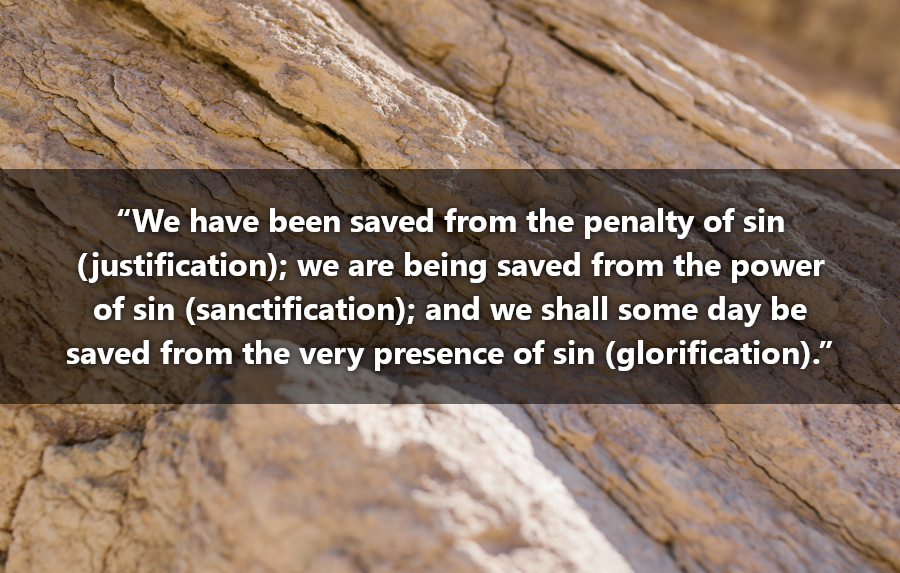The Resurrection Body of Christ the Lord, Part 9
Image

Read the series.
Our salvation by God’s infinite grace will be fully manifested when we behold our resurrected Savior in glory. Thus, “it is high time to awake out of sleep: for now is our salvation nearer than when we believed” (Rom. 13:11, KJV).
What we have experienced, namely, full justification before God by faith, and what we are experiencing, namely, progressive sanctification, will be completed on that great day! “He which hath begun a good work in you will perform it until the day of Jesus Christ” (Phil. 1:6).
So important is this threefold aspect of personal salvation that the apostle Paul expressed it again in his letter to the Colossians:
If ye then be risen with Christ [i.e., justification and identification], seek those things which are above, where Christ sitteth on the right hand of God. Set your affection on things above, not on things on the earth [i.e., progressive sanctification]… . When Christ, who is our life, shall appear, then shall ye also appear with him in glory [i.e., glorification]. (Col. 3:1-2, 4)
Thus, we have been saved from the penalty of sin (justification); we are being saved from the power of sin (sanctification); and we shall some day (perhaps today!) be saved from the very presence of sin (glorification). It is for this reason that many churches today participate in a three-fold communion service in order to illustrate these basic truths of our salvation, following the example set by the early church. Evangelical churches everywhere agree that the bread and the cup illustrate the substitutionary work of Christ upon the cross (our justification) because our Lord stated that by means of these symbols we “shew the Lord’s death till he come” (1 Cor. 11:26).
But this divinely revealed ordinance was to be the climax of the washing of the saints’ feet, which our Lord commanded us to observe as an illustration of our need of daily cleansing (sanctification—see John 13:14-17). It was also the climax of “the Lord’s Supper” (1 Cor. 11:20; cf. vv. 25, 33), which was not the bread and the cup, but rather a full meal called the “feast of charity” or “love-feast” (Greek: agape—Jude 12). Paul tells us that it was “when He had supped” (i.e., the Lord’s Supper—1 Cor. 11:20) that the bread and the cup were to be taken (1 Cor. 11:25).
At the very dawn of the church’s existence, believers “continued steadfastly in … (the) breaking of (the) bread” (Acts 2:42). In the words of a prominent New Testament Greek scholar,
The presence of the articles in the expression ‘the breaking of the bread’ (Greek: tēi klasei tou artou) indicates more than just eating. It appears to be a reference to the symbolic eating of the Bread and the Cup, partaken in connection with a sacred meal, the Agape. (Homer A. Kent, Jr., Jerusalem to Rome: Studies in Acts. Winona Lake, IN: BMH Books, 1972, p. 34)
Later, the apostle Paul shared such a meal with the saints of Troas. “Upon the first day of the week … the disciples came together to break bread” (Acts 20:7; cf., v. 11). Kent states:
The observance of the Lord’s Supper was a principal reason for the gathering. As was the custom in the early church, the partaking of the bread and cup seems here to have been combined with an agape or love feast. The word ‘eaten’ (Greek: geusamenos) (20:11) is used elsewhere in the NT of the satisfying of hunger (not just a sampling) and could easily denote the agape. (Ibid., p. 156)
But what was the purpose of this special meal—”the Lord’s Supper” or the agape? God willing, that will be our next study.
John Whitcomb 2020
Dr. John C. Whitcomb (1924-2020) founded Whitcomb Ministries, Inc. He served as professor of Old Testament and theology for 60 years and is widely recognized as a leading biblical scholar. The book he coauthored with the late Dr. Henry Morris in 1961, The Genesis Flood, has been credited as one of the major catalysts for the modern biblical creationism movement. Dr. Whitcomb’s broadcasts, sermons, lectures and writings are available at SermonAudio.
- 28 views


Discussion